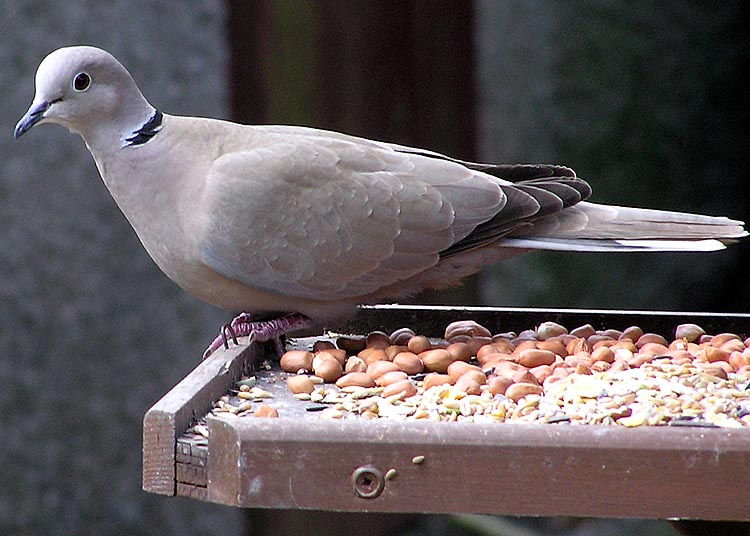|
| Query: rock-pigeon | Result: 67th of 71 | |
Eurasian Collared Dove (Streptopelia decaocto) - Wiki
| Subject: | Eurasian Collared Dove (Streptopelia decaocto) - Wiki
| |

| Resolution: 750x536
File Size: 102435 Bytes
Date: 2004:05:23 00:50:21
Camera: C750UZ (OLYMPUS CORPORATION)
F number: f/3.7
Exposure: 10/1250 sec
Focal Length: 630/10
Upload Date: 2006:12:24 13:53:51
|
Eurasian Collared Dove
From Wikipedia, the free encyclopedia
[Photo] Collared Dove in an English garden. The bird had just finished a meal of peanuts from the bird table. Taken by Adrian Pingstone in May 2004 and released to the public domain.
The Eurasian Collared Dove, Streptopelia decaocto, also called the Eurasian Collared-Dove or simply the Collared Dove, is one of the great colonisers of the avian world. Its original range was warmer temperate regions from southeastern Europe to Japan. However, in the twentieth century it expanded across the rest of Europe, reaching as far west as Great Britain by 1953, and Ireland soon after. It also now breeds north of the Arctic Circle in Scandinavia. It is not migratory.
It was introduced into the Bahamas in the 1970s and spread to Florida by 1982. Its stronghold in North America is still the Gulf Coast, but it is now found as far south as Veracruz, as far west as California, and as far north as British Columbia and the Great Lakes. Its impact on native species is as yet unknown; it appears to occupy an ecological niche between that of the Mourning Dove and Rock Pigeon; some have suggested that its spread represents exploitation of a niche made available by the extinction of the Passenger Pigeon.
It breeds wherever there are trees for nesting, laying two white eggs in a stick nest. Incubation lasts 14-18 days, and young fledge after 15-19 days. It is not wary and is often found around human habitation.
This is a small dove, buff grey with a darker back and a blue-grey wing patch. The tail feathers are tipped white. It has a black half-collar on its nape from which it gets its name. The short legs are red and the bill is black. The eye is reddish brown. From a distance the eyes appear to be black, as the pupil is relatively large and only a narrow rim of reddish-brown eye colour can be seen around the black pupil (click on photo to see features in detail).
This is a gregarious species, and sizeable winter flocks will form where there are food supplies such as grain. The song is a coocoo, coo repeated many times. It is phonetically similar to the Greek decaocto ('eighteen'), to which the bird owes its name. Occasionally it also makes a harsh loud mechanical-sounding call lasting about 2 seconds, particularly when landing in the summer.
The Eurasian Collared Dove is one of two species (the other, and the more likely, being the African Collared Dove, Streptopelia roseogrisea) that have been argued to be the wild ancestor of the domestic Barbary Dove, S. risoria. It is able to interbreed with the Barbary Dove.
http://en.wikipedia.org/wiki/Eurasian_Collared_Dove
| The text in this page is based on the copyrighted Wikipedia article shown in above URL. It is used under the GNU Free Documentation License. You may redistribute it, verbatim or modified, providing that you comply with the terms of the GFDL. |
|
Comments |
|---|
| | ANITA M |
|
WE JUST SAW 2 OF THESE BEAUTIFUL COLLARED DOVES IN OUR BACKYARD
THIS MORNING AT THE FEEDERS. WE HAVE 2 TYPES BUT NEVER SAW ANY LIKE
THESE. THEY ARE LOVELY. WISH THEY WOULD STAY, BUT KNOW LIKE SO MANY
OTHERS THEY STOPPED FOR A DRINK, FOOD AND REST.HA
THANKS FOR THE INFO HERE. |
| | ANITA M |
|
ref my last message. I FORGOT TO SAY THESE COLLERED DOVES WERE SEEN IN
TYLER, TEXAS. THEY ARE STILL HERE. THEY COME IN FOR GRAIN AND WATER.
SO PRETTY. |
^o^
Animal Pictures Archive for smart phones
^o^
|
|
|

